New Study Published at the Kasigau Corridor REDD+ Project
- Wildlife Works
- Jan 8, 2024
- 2 min read
Updated: Apr 12, 2024

In the face of climate change, how is the diversity of birds affected by elevation, temperature, seasonal changes and human disturbance?
Members of the Wildlife Works Biodiversity team, consisting of Geoffrey Mwangi, Bernard Amakobe and Mwangi Githiru, recently published a decade-long study of birds along an elevational gradient in Mt. Kasigau to answer this question. The study was designed by Wildlife Works Global Director for Conservation, Mwangi Githiru, and is the first comprehensive, multi-year assessment of understorey birds in Kenya's portion of the Eastern Arc Mountains, a global biodiversity hotspot and an Important Bird Area.
Montane areas host over half of the world's biodiversity hotspots. In higher altitudes, conditions tend to be harsh (low temperatures and frequent rain). Many mountain ranges in the tropics have unique species, since species must specialize to thrive in these harsh environments. Previous studies have shown that the number of species of birds generally declines with increasing elevation. However, montane ecosystems will most likely provide refuge for species displaced by a warming climate.
Our team used systematic bird ringing data over a 10-year period to assess bird populations at four elevation levels ranging from 858 to 1547m on Mt. Kasigau.

Map of the Wildlife Works Kasigau Corridor REDD+ Project in Kenya, highlighting Mt. Kenya, the focal point of this study
Our team of researchers found that the abundance of birds declined with increasing elevation for the lower three elevation levels but peaked at the highest elevation. Elevation had a greater effect on which species were present than the season, human disturbance and temperature.
There was a greater diversity of bird species in the wet season compared to the dry season across all the years. This makes sense as with more rain, comes more resources to support a greater number of species. However, the team observed a significant shift from historic rainfall patterns on Mt. Kasigau. During this study, Kenya experienced its worst drought in forty years. As the planet warms and droughts become more common, thermal refuges like Mt. Kasigau will be critical for endangered birds. Our team noted that climate change is already affecting the behavior of certain species. For example, the Striped Pipit was recorded at higher altitudes than previously known, suggesting an upward shift of its range into cooler territory.

The Striped Pipit (Anthus lineiventris)
Geoffrey Mwangi, lead biodiversity and social monitoring scientist at the Kasigau Corridor REDD+ project says, “This study highlights the importance of improved conservation planning to better conserve montane areas which are regarded as future refuges for biodiversity as the planet continues to experience global warming. The future of biodiversity planning should take cognizance of threats posed by global warming and climate change. We are grateful to Wildlife Works for its commitment to science, and this long-term study is likely to reveal further insights on how sensitive taxa such as birds in montane areas respond to climate change.”
To learn more, read the full research paper:



